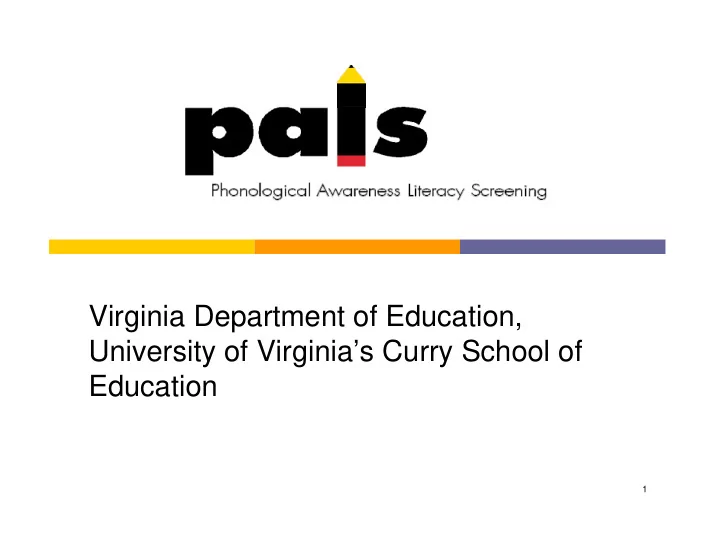

Virginia Department of Education, University of Virginia’s Curry School of Education 1
3
PALS Instrument Content Areas PALS-PreK PALS-K PALS 1-3 Print and Word Awareness X Nursery Rhyme Awareness X Name Writing X Rhyme Awareness X X Beginning Sound Awareness X X Alphabet Knowledge X X X Letter Sounds X X X Concept of Word X X Blending X X Sound-to-letter X X Spelling X X Word Recognition in isolation X X Fluency X 4
Technical Adequacy of PALS � Development, field-testing, & on-going evaluation have been guided by the Standards for Educational & Psychological Tests, published jointly by the: � American Educational Research Association (AERA) � American Psychological Association (APA) � National Council on Measurement in Education (ECME) 5
Reliability & Validity � Does PALS Produce Consistent Results? PALS provides consistent scores across a broad range of students and can be scored reliably by different teachers. � Does PALS Measure What it Purports to Measure? PALS measures literacy skills predictive of important achievement outcomes on standardized reading tests and Standards of Learning (SOL) in English/Reading. 6
Reading Fundamentals Teachers learn the components of effective reading instruction by assessing with PALS. 7
Instructional Transparency Teachers can use PALS results to create instructional groups, plan for instruction & intervention, and monitor progress over time 8
PALS Web site Online Score Entry & Reporting System http://pals.virginia.edu 9
Looking at Data The PALS website helps schools and districts look at their own data and to use their data to make instructional decisions 13
14 14
Cohort Year 1: K ID Rates 2002-2003 25 20 % Ide ntifie d ID Fa ll% 15 ID Spring % 10 5 0 State Distric t Sc ho o l 15
Percentage of 2 nd graders at different oral reading levels at Mid-Year and Spring 60 50 40 MidYear 30 Spring 20 10 0 1st 1,2 2nd 2,3 3rd 3,4 16
Number of First Graders at Different Instructional Oral Reading Levels, Spring 2006 (n = 72,129) 14,000 12,000 number of students 10,000 8,000 6,000 4,000 2,000 0 s r r t d d h h h e e s s r t t n t r x m m i r f e i o h i u f f i s n t i i c o r r i p p e d f s e a r e p r instructional oral reading level 17
First Grade Instructional Oral Reading Levels by SES Decile Groups, Spring 2006 80% 70% percentage of students 60% 50% Below 40% On 30% Above 20% 10% 0% 0 - 10.1% 10.1 - 20.2 - 27.0 - 34.6 - 40.9 - 49.0 - 55.8 - 63.4 - > 73.6% 20.2% 27.0% 34.6% 40.9% 49.0% 55.8% 63.4% 73.6% SES decile groups (% free/reduced lunch) 18
19
20
21
22
23
Support Teachers receive support from the PALS office through email, the hotline, and the PALS website. 24
25 25
The Numbers ~ 2006-2007 500,000 complete score histories � 80,000 score transfers � 6,000 phone calls to 1-888-UVA-PALS � 2,000 emails to pals@virginia.edu � 26 26
27
Recommend
More recommend